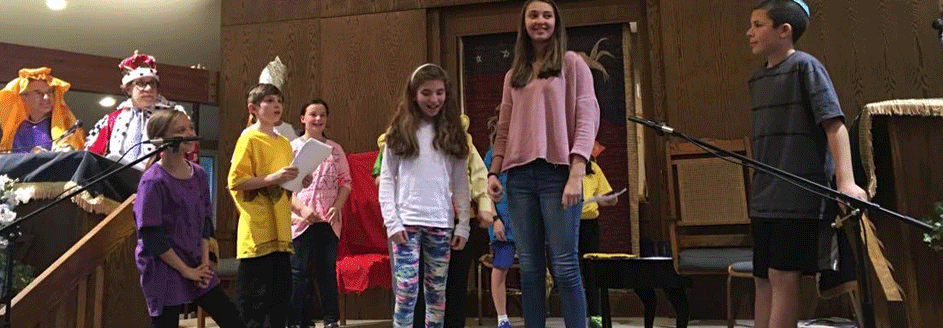
We often think of Purim with its costumes and noisemakers as a children’s holiday. But its themes and ideas are of great importance to Jewish life. In fact, our tradition tells us that we are to drop whatever we are doing, no matter its importance, to go and listen to the story of Purim.
What is the Story of Purim?
This story in the Book of Esther takes place in the land of Persia (today’s Iran) at the time when Ahashverosh (aka Ahasuerus) was king. King Ahashverosh held a banquet in his capital city of Shushan and ordered his queen,Vashti, to come and dance before his guests. She refused to appear and lost her royal position.
Based on advice from his counselors, Ahashverosh held a pageant to choose a new queen. Mordechai, a Jewish man living in Shushan, encouraged his cousin, Esther, to enter the competition. Esther won but, following the advice of her cousin, did not reveal her Jewish origin.
Mordechai often sat near the gate of the king’s palace. One day he overheard two men, Bigthan and Teresh, plotting to kill the king. Mordechai reported what he had heard to Esther. She then reported the information to the king. The matter was investigated and found to be true. Bigthan and Teresh came to an unfortunate end. Mordechai’s deed was recorded, but his actual reward came later.
Meanwhile, the king’s evil adviser, Haman, paraded through the streets, demanding that all bow to him. Mordechai refused, since Jews are not supposed to bow to anyone but God. Upon finding out that Mordechai is Jewish, Haman decided to kill all the Jews in the Persian empire. He plotted to kill them and cast purim (“lots,” plural of pur), a kind of lottery, to determine the day on which he would carry out his evil deed: the 13th of Adar. Haman also convinced King Ahashverosh to go along with his plan, although in the M’gillah, Haman never identified the Jews as the people he wished to destroy.
He convinces the king to decree that all of the Jews in the land should be killed on the 13th of the month of Adar. Mordechai alerted Esther to Haman’s evil plot, and Esther revealed her Jewishness to the King and convinced him to save the Jews, foiling Haman’s plot. Haman was hanged, Mordechai received his estates and position of royal vizir, and the Jews of Persia celebrated their narrow escape on the 14th of Adar, the day after they were supposed to be annihilated.
Thus, the fate that Haman had planned for the Jews became his own. The holiday of Purim celebrates the bravery of Esther and Mordechai and the deliverance of the Jewish people from the cruelty of oppression.
What is the M’gilah?
M’gilah means scroll, most often referring to M’gilat Esther, literally “The Scroll of Esther,” also known as the “Book of Esther.”
According to the Talmud, “The study of Torah is interrupted for the reading of the M’gillah.” And Maimonides (a 12th century sage and rabbi) teaches, “The reading of the M’gillah certainly supersedes all other mitzvot.” (Maimonides,Yad, M’gillah 1:1)
Traditionally, congregations gather together to read the M’gilah at both the evening and morning services on Purim. When the name of Haman is read, congregants use noisemakers to drown out the sound of his name.
What does Purim celebrate?
Purim celebrates the Jews’ escape from extinction in Persia. In fact, their complete victory in the story is such an inversion of what might have happened that the holiday is celebrated with general silliness and merry-making.
What are some of the customs of Purim?
In the Book of Esther, we read that Purim is a time for “feasting and merrymaking” as well as for “sending gifts to one another and presents to the poor” (Esther 9:22). In addition to reading the M’gilah, celebrants dress up in costumes; have festive parties; perform silly theatrical adaptations of the story of the M’gilah called “Purim spiels”; send baskets of food to friends called mishloach manot; and give gifts to the poor called matanot l’evyonim.
What are mishloach manot?
Mishloach manot are gifts of food that friends (and prospective new friends!) give to one another on Purim. Most include the traditional Purim food of hamentaschen, but many include a wide variety of foods and treats. They’re also commonly referred to by their Yiddish name, shalachmanos.
What are hamentaschen?
Hamantaschen are a three-cornered cookies with poppy, preserves, chocolate, or other fillings in the center. More information about Hamantaschen, including some delicious recipes, can be found here.
What are Matanot l’evyonim?
Matanot l’evyonim are gifts to the poor so that they, too, can celebrate Purim with a special meal.
What is a Purim-spiel?
A Purim-spiel (pronounced SHPEEL, rhymes with “reel”) is a humorous skit presented on Purim. Most of them parody the story of the Book of Esther, but it is also common for congregations to take the opportunity to poke some gentle fun at themselves and their idiosyncrasies.

